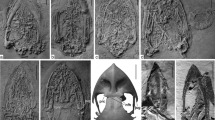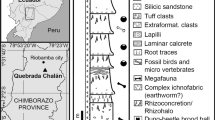Abstract
The fossil record of owls (Strigiformes) is one of the most extensive among the neornithine birds, yet at the same time largely restricted geographically to Europe and North America. Various fossil owls are known from the Paleocene (ca. 60 Ma) to Recent. Here we present the first taxonomic description of new species of Paleogene owls from Asia, two new taxa from the Eocene and Oligocene of Mongolia. The anatomy of Heterostrix tatsinensis gen. et sp. nov., represented by a complete Early Oligocene tarsometatarsus, sheds light on the evolution of perching adaptations in these birds and expands the family diversity of this order. Eostrix tsaganica sp. nov. from the Early Eocene extend the known range of the protostrigid genus Eostrix into Asia (the other known species come from Europe and western North America). The paper also provides a review of the fossil record of owls, which gives evidence for the Late Cretaceous evolutionary radiation of this lineage. In spite of the absence of specimens from the Mesozoic, fossil owl collector-effort (since the 1860s) suggests that, in contrast to many other avian clades, the fossil record of these birds is complete enough for biological signal to be extracted.
Similar content being viewed by others
References
Badamgarav, D. and Reshetov, V.Yu., Paleontology and Stratigraphy of the Paleogene of Transaltaic Gobi, Tr. Sovmestn. Sovet.-Mongol. Paleontol. Eksped., 1985, vol. 25, pp. 1–104.
Baumel, J.J. and Witmer, L.M., Osteologia, in Handbook of Avian Anatomy: Nomina Anatomica Avium, 2nd ed. Cambridge, MA: Publ. Nutt. Ornithol. Club. 1993, vol. 23, pp. 45–132.
Bleiweiss, R., Fossil Gap Analysis Supports Early Tertiary Origin of Trophically Diverse Avian Orders, Geology, 1998, vol. 26, no. 4, pp. 323–326.
Brodkorb, P., Catalogue of Fossil Birds: Part 4 (Columbiformes through Piciformes), Bull. Florida St. Mus., 1971, vol. 15, no. 4, pp. 163–266.
Cheneval, J., Ginsburg, L., Mourer-Chauviré, C., and Ratanasthien, B., The Miocene Avifauna of the Li Mae Long Locality, Thailand: Systematics and Paleoecology, J. Southeast Asian Earth Sci., 1991, vol. 6, no. 2, pp. 117–126.
Clarke, J.A., Tambussi, C.P., Noriega, J.I., et al., Definitive Fossil Evidence for Extant Avian Radiation in the Cretaceous, Nature, 2005, vol. 433, no. 7023, pp. 305–308.
Cracraft, J., Barker, F.K., Braun, M.J., et al., Phylogenetic Relationships among Modern Birds (Neornithes): Toward an Avian Tree of Life, in Assembling the Tree of Life, Cracraft, J. and Donoghue, M.J., Eds., New York: Oxford Univ. Press, 2004, pp. 468–489.
Devyatkin, E.V., Magnetostratigraphic Scheme of the Cenozoic in Mongolia, Stratigr. Geol. Korrelyatsiya, 1994, vol. 2, no. 2, pp. 33–45 [Stratigr. Geol. Correl., 1994, vol. 2, no. 2, pp. 145–157].
Feduccia, A., The Origin and Evolution of Birds. New Haven-London: Yale Univ. Press, 1999.
Fischer, K., Oligostrix rupelensis n. gen., n. sp., eine neue Ureule (Protostrigidae, Strigiformes, Aves) aus dem marinen Mitteloligozän des Weisselsterbeckens bei Leipzig (DDR), Z. Geol. Wiss., Berlin, 1983, vol. 11, no. 4, pp. 483–487.
Ford, N.L., A Systematic Study of the Owls Based on Comparative Osteology, PhD Theses (Zoology), Univ. Michigan, 1967, pp. 1–128.
Fountaine, M.R., Benton, M.J., Dyke, G.J., and Nudds, R.L., The Quality of the Fossil Record of Mesozoic Birds, Proc. R. Soc. London B, 2005, vol. 272, no. 1560, pp. 289–294.
Harrison, C.J.O., A Small Owl from the Lower Eocene of Britain, Tertiary Res., 1980, vol. 3, no. 2, pp. 83–87.
Harrison, C.J.O. and Walker, C.A., The Bradycnemidae, a New Family of Owls from the Upper Cretaceous of Romania, Palaeontology, 1975, vol. 18, no. 3, pp. 563–570.
Höck, V., Daxner-Höck, G., Schmid, H.P., et al., Oligocene-Miocene Sediments, Fossils and Basalts from the Valley of Lakes (Central Mongolia)-An Integrated Study, Mitt. Österr. Geol. Ges., 1999, vol. 90, pp. 83–125.
Hope, S., The Mesozoic Radiation of Neornithes, Mesozoic Birds: Above the Heads of Dinosaurs, Chiappe, L.M. and Witmer, L.M., Eds., Berkeley, Los Angeles: Univ. Calif. Press, 2002, pp. 339–388.
Hou, L., The Aragonian Vertebrate Fauna of Xiacaowan, Jiangsu: 6. Aves, Vertebr. PalAsiat., 1987, vol. 25, no. 1, pp. 57–68.
Hou, L., Avian Fossil of Pleistocene of Zhoukoudian, Mem. Inst. Vertebr. Palaeontol. Palaeoanthropol., Acad. Sin., 1993, vol. 19, pp. 165–296.
Houde, P. and Olson, S.L., A Radiation of Coly-like Birds from the Eocene of North America (Aves: Sandcoleiformes New Order), Natur. Hist. Mus. Los Angeles Co. Sci. Ser., 1992, no. 36, pp. 137–160.
Kurochkin, E.N., Birds of the Central Asia in Pliocene, Tr. Sovmestn. Sovet.-Mongol. Paleontol. Eksped., 1985, vol. 26, pp. 1–120.
Kurochkin, E.N., A Survey of the Paleogene Birds of Asia, Smithson. Contrib. Paleobiol., 1976, no. 27, pp. 75–86.
Kurochkin, E.N., Synopsis of Mesozoic birds and Early Evolution of Class Aves, Archaeopteryx, 1995, vol. 13, pp. 47–66.
Kurochkin, E.N., Dyke, G.J., and Karhu, A.A., A New Presbyornithid Bird (Aves, Anseriformes) from the Late Cretaceous of Southern Mongolia, Am. Mus. Novit., 2002, no. 3396, pp. 1–11.
Li, J., Wu, X., and Zhang, F. (Eds.), The Chinese Fossil Reptiles and Their Kin, 2nd ed., Beijing: Sci. Press.
Livezey, B.C. and Zusi, R.L., Higher-order Phylogeny of Modern Birds (Theropoda, Aves): Neornithes Based on Comparative Anatomy: II. Analysis and Discussion, Zool. J. Linn. Soc., 2007, vol. 149, no. 1, pp. 1–95.
Martin, L.D. and Black, C.C., A New Owl from the Eocene of Wyoming, Auk, 1972, vol. 89, no. 4, pp. 887–888.
Mayr, G., Paleogene Fossil Record of Birds in Europe, Biol. Rev., 2005a, vol. 80, pp. 515–542.
Mayr, G., The Postcranial Osteology and Phylogenetic Position of the Middle Eocene Messelastur gratulator Peters, 1994—A Morphological Link between Owls (Strigiformes) and Falconiform Birds?, J. Vertebr. Paleontol., 2005b, vol. 25, pp. 635–645.
Mayr, G., A Small Loon and a New Species of Large Owl from the Rupelian of Belgium (Aves: Gaviiformes, Strigiformes), Paläontol. Z., 2009, vol. 83, no. 2, pp. 247–254.
Mayr, G. and Clarke, J., The Deep Divergences of Neornithine Birds: A Phylogenetic Analysis of Morphological Characters, Cladistics, 2003, vol. 19, no. 6, pp. 527–553.
Mayr, G., Manegold, A., and Johansson, U.S., Monophyletic Groups within “Higher Land Birds”—Comparison of Morphological and Molecular Data, J. Zool. Syst. Evol. Res., 2003, vol. 41, no. 4, pp. 233–248.
Mlíkovsky-, J., Cenozoic Birds of the World: Part 1. Europe, Praha: Ninox Press, 2002.
Mourer-Chauviré, C., Minerva antiqua (Aves, Strigiformes), an Owl Mistaken for an Edentate Mammal, Am. Mus. Novit., 1983, no. 2773, pp. 1–11.
Mourer-Chauviré, C., Les Strigiformes (Aves) des phosphorites du Quercy (France): Systematique, Biostratigraphie et Paléobiogeographie, Docum. Lab. Géol. Lyon, 1987, no. 99, pp. 89–135.
Mourer-Chauviré, C., A Large Owl from the Palaeocene of France, Palaeontology, 1994, vol. 37, part 2, pp. 339–348.
Naish, D.W. and Dyke, G.J., Heptasteornis Was not Ornithominid, Troodontid, Dromaeosaurid or Owl: The First Alvarezsaurid (Dinosauria: Theropoda) from Europe, Neues Jahrb. Geol. Palaeontol., 2004, vol. 7, pp. 385–401.
Nessov, L.A., Mesozoic and Paleogene Birds of the USSR and Their Paleoenvironments, Natur. Hist. Mus. Los Angeles Co. Sci. Ser., 1992, no. 36, pp. 465–478.
Olson, S.L., The Fossil Record of Birds, in Avian Biology, Farner, D.S., King, J.R., and Parkes, K.C., Eds., New York: Acad. Press, 1985, vol. 8, pp. 79–238.
Raikow, R.J., Locomotor System, in Form and Function in Birds, King, A.S. and McLelland, J., Eds., London: Acad. Press, 1985, vol. 3. pp. 57–147.
Rich, P.V., Tarsometatarsus of Protostrix from the Mid-Eocene of Wyoming, Auk, 1982, vol. 99, no. 2, pp. 576–579.
Shufeldt, R.W., Further Studies on Fossil Birds with Description of New and Extinct Species, Bull. Am. Mus. Natur. Hist., 1913, vol. 32, art. 16, pp. 285–306.
Sibley, C.G. and Ahlquist, J.E., Phylogeny and Classification of Birds: A Study in Molecular Evolution, New Haven: Yale Univ. Press, 1990.
Sieradzki, A.E., Johnson, D.H., Radley, P., et al., Original Literature Describing the Entire Order of Strigiformes (Extant and Fossil Genera, Species and Subspecies) 1758–2007. 2007. http://www2.nrm.se/ve/birds/sape/GlobalOwl-Project/Fossil-owls/Fossil.html.
Vickers Rich, P. and Bohaska, D.J., The World’s Oldest Owl: A New Strigiform from the Paleocene of Southwestern Colorado, Smithson. Contrib. Paleobiol., 1976, no. 27, pp. 87–93.
Vickers Rich, P. and Bohaska, D.J., The Ogygoptyngidae, a New Family of Owls from the Paleocene of North America, Alcheringa, 1981, vol. 5, no. 2, pp. 95–102.
Wetmore, A., The Status of Minerva antiqua, Aquila ferox, and Aquila lydekkeri As Fossil Birds, Am. Mus. Novit., 1933, no. 680, pp. 1–4.
Wetmore, A., Another Fossil Owl from the Eocene of Wyoming, Proc. US Nat. Mus., 1938, vol. 85, no. 3031, pp. 27–29.
Zelenkov, N.V. and Dyke, G.J., The Fossil Record and Evolution of Mousebirds (Aves: Coliiformes), Palaeontology, 2008, vol. 51, part 6, pp. 1403–1418.
Author information
Authors and Affiliations
Corresponding author
Additional information
Original Russian Text © E.N. Kurochkin, G.J. Dyke, 2011, published in Paleontologicheskii Zhurnal, 2011, No. 4, pp. 85–97.
Rights and permissions
About this article
Cite this article
Kurochkin, E.N., Dyke, G.J. The first fossil owls (Aves: Strigiformes) from the Paleogene of Asia and a review of the fossil record of Strigiformes. Paleontol. J. 45, 445–458 (2011). https://doi.org/10.1134/S003103011104006X
Received:
Published:
Issue Date:
DOI: https://doi.org/10.1134/S003103011104006X




